外研版(2019)必修 第一册 Unit 1 A new startUsing language Grammar 课件(共35张)
文档属性
| 名称 | 外研版(2019)必修 第一册 Unit 1 A new startUsing language Grammar 课件(共35张) | 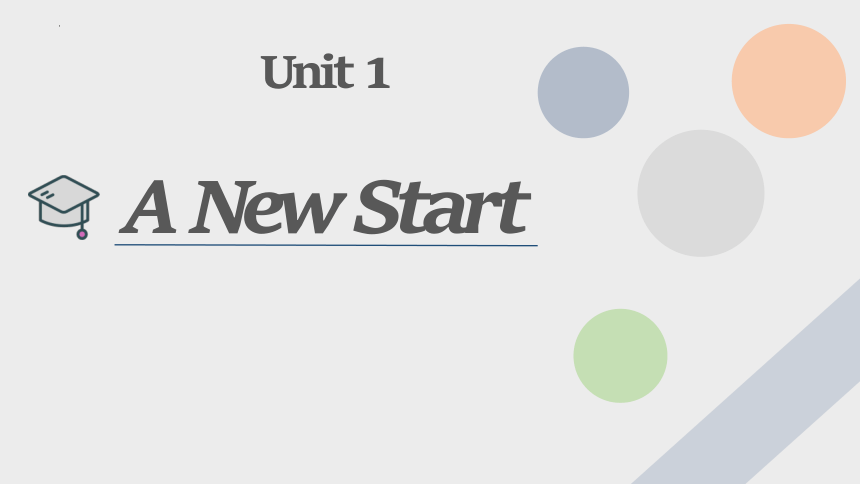 | |
| 格式 | pptx | ||
| 文件大小 | 1.1MB | ||
| 资源类型 | 教案 | ||
| 版本资源 | 外研版(2019) | ||
| 科目 | 英语 | ||
| 更新时间 | 2025-05-02 10:32:21 | ||
图片预览

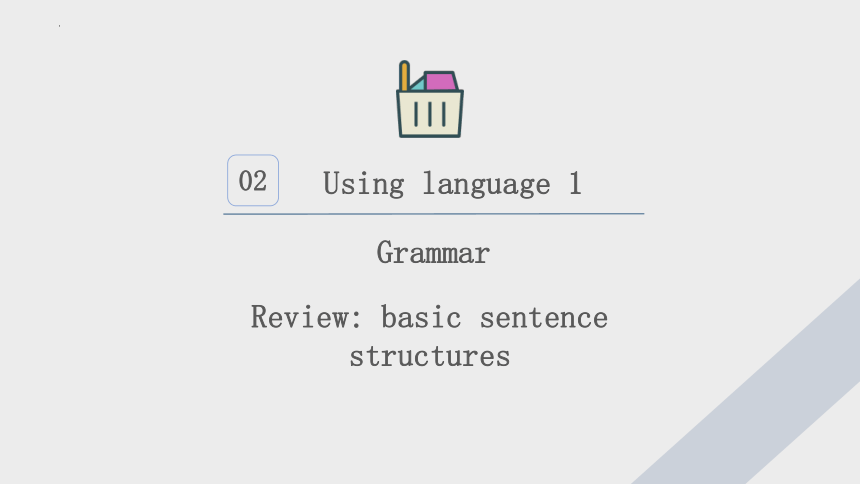
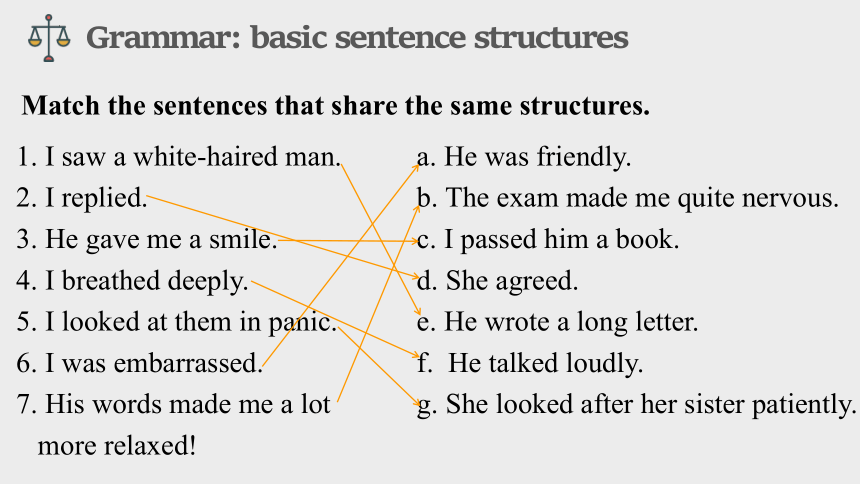

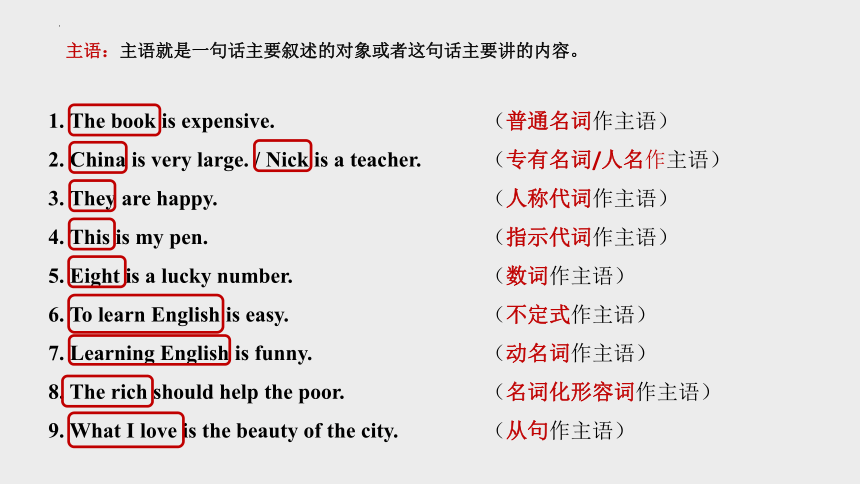




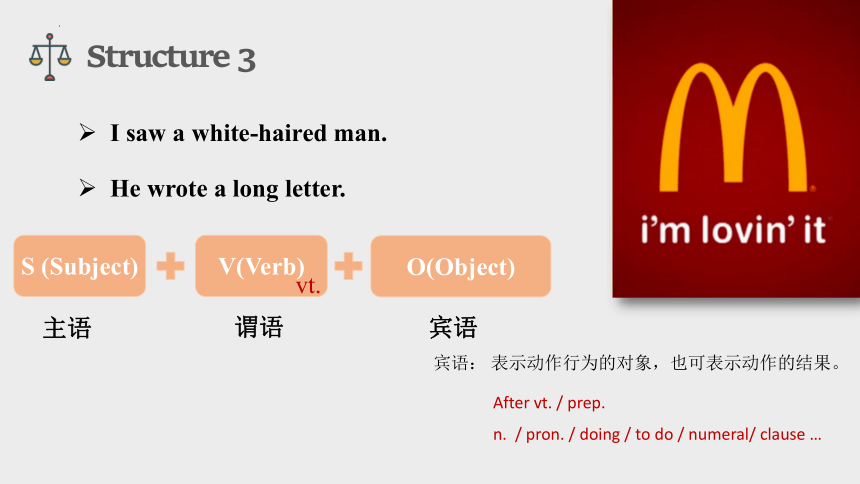


文档简介
(共35张PPT)
Unit 1
A New Start
Using language 1
02
Grammar
Review: basic sentence structures
Grammar: basic sentence structures
Match the sentences that share the same structures.
1. I saw a white-haired man.
2. I replied.
3. He gave me a smile.
4. I breathed deeply.
5. I looked at them in panic.
6. I was embarrassed.
7. His words made me a lot
more relaxed!
a. He was friendly.
b. The exam made me quite nervous.
c. I passed him a book.
d. She agreed.
e. He wrote a long letter.
f. He talked loudly.
g. She looked after her sister patiently.
Structure 1
I replied.
She agreed.
S (Subject)
V (Verb)
主语
谓语
主语: 句子所要描述或说明的主体;表示句子说的是什么人或什么事相关的信息。
Usually at the beginning of a sentence
n. / pron. / doing / to do / numeral/ clause …
vi.
主语:主语就是一句话主要叙述的对象或者这句话主要讲的内容。
1. The book is expensive.
2. China is very large. / Nick is a teacher.
3. They are happy.
4. This is my pen.
5. Eight is a lucky number.
6. To learn English is easy.
7. Learning English is funny.
8. The rich should help the poor.
9. What I love is the beauty of the city.
(普通名词作主语)
(专有名词/人名作主语)
(人称代词作主语)
(指示代词作主语)
(数词作主语)
(不定式作主语)
(动名词作主语)
(名词化形容词作主语)
(从句作主语)
Structure 1
I replied.
She agreed.
S (Subject)
V (Verb)
主语
谓语
主语: 句子所要描述或说明的主体;表示句子说的是什么人或什么事相关的信息。
Usually at the beginning of a sentence
n. / pron. / doing / to do / numeral/ clause …
谓语:说明主语的动作或状态。
Usually after the subject
verb/ phrasal verb
vi.
②谓语:说明主语动作或者状态的词语。
牢记:
只有动词原形(do)及其因人称和时态的变形 可以充当谓语!
“to do, doing, done”三种形式为非谓语动词!
1. She eats an apple every day.
2. I have finished my homework already.
3. They went to the part together.
4. We should use every chance to learn.
5. I was a student 10 years ago.
6. Where did you go last night
Structure 2
I was embarrassed.
He was friendly.
S (Subject)
Linking Verb
主语
系动词
P(Predicative)
表语
常见的连系动词有:
be动词
感官动词:feel, look, smell, sound, taste
3) 表示“变化”的词:become, come, fall, get, go, grow, turn
4) 表示“保持”:keep, remain, stay
5) 表示“好像”:appear, seem
6) 表示“证明”:prove (to be), turn out (to be)
表语: 表示主语的身份、状态、性质、特征等。
After the linking verb
n. / adj. /numeral/ to do/ doing/ preposition phrase/clause …
③表语:说明主语的身份、性质、状况等含义的成分(表语就是对主语的补充说明)
出现在系动词后
Her face turned red.
He is a boy.
Five plus two is seven.
We are here.
The house is on fire.
Seeing is believing.
Our duty is to make our environment better.
This is what I want.
(形容词作表语)
(名词作表语)
(数词作表语)
(副词作表语)
(介词短语作表语)
(动名词作表语)
(不定式作表语)
(从句作表语)
Structure 3
I saw a white-haired man.
He wrote a long letter.
S (Subject)
V(Verb)
主语
谓语
O(Object)
宾语
宾语: 表示动作行为的对象,也可表示动作的结果。
After vt. / prep.
n. / pron. / doing / to do / numeral/ clause …
vt.
④宾语:指一个动作(动词)的对象, 出现在谓语动词后或介词后
1. She bought a house yesterday.
2. He said nothing during the meeting.
3. He pretended not to see me.
4. I enjoy listening to popular music.
5. I have finished two of the assignments.
6. We need to help the disabled.
7. You don’t understand what I said.
(名词作宾语)
(代词作宾语)
(不定式短语)
(动名词短语)
(数词作宾语)
(名词化形容词作宾语)
(从句作宾语)
Structure 4
He gave me a smile.
I passed him a book.
S
V
主语
谓语
Indirect Object
间接宾语
Direct Object
直接
宾语
宾语: 表示动作行为的对象,也可表示动作的结果。
vt.
sb.
sth.
After vt. / prep.
n. / pron. / doing / to do / numeral/ clause …
Structure 5
His words made me a lot more relaxed.
The exam made me quite nervous.
S
V
主语
谓语
O
宾语
C(Complement)
宾语补足语
宾语补足语: 补充说明宾语的动作或状态。
After the object
n. / adj. /adv. / numeral/ to do/ doing/ preposition phrase …
vt.
⑤宾语补足语(即复合宾语):某些及物动词不仅需要宾语,而且还要求某个词或词组来补充说明宾语.
We made him a birthday cake.
I tried my best to make him happy.
Please let him in.
I put my family first.
We call him a nice man.
He advised me to give up smoking.
I saw him running down the street.
I found him reading my letter.
I noticed him in tears.
(名词作宾补)
(形容词作宾补)
(副词作宾补)
(数词作宾补)
(名词短语作宾补)
(不定式短语作宾补)
(动名词短语作宾补)
(现在分词作宾补)
(介词短语作宾补)
Structure 6
I breathed deeply.
He talked loudly.
S (Subject)
V(Verb)
主语
谓语
A(Adverbial)
状语
状语: 用来修饰动词、形容词、副词或整个句子
位置灵活,可位于句首,句中,句末
adv./ preposition phrase/ doing/done/ to do/ clause…
vi.
Structure 7
I looked at them in panic.
She looked after her sister patiently.
S
V
主语
谓语
O
宾语
A(Adverbial)
状语
vt.
状语: 用来修饰动词、形容词、副词或整个句子
位置灵活,可位于句首,句中,句末
adv./ preposition phrase/ doing/done/ to do/ clause…
⑦状语:用来修饰动词、形容词或整个句子
通常由副词,副词短语,介词短语或句子充当
状语分为很多种,有时间状语,地点状语,方式状语,原因状语,目的状语等等
状语位置极其灵活,可根据具体情况放在不同位置
The children were playing in the park.
He did not play well enough.
He did not play well enough to win.
She always comes to my house.
I won’t go shopping if it rains this afternoon.
Getting up late, he hurried to school.
(介词短语作状语/表地点)
(副词短语作状语/表程度)
(不定式作状语/表目的)
(副词作状语/表频率)
(从句作状语/表条件)
(分词短语作状语/表原因)
Summary
Basic
sentence structures
主谓 (SV)
主系表 (SVP)
主谓宾 (SVO)
主谓宾宾 (SVOO)
主谓宾补 (SVOC)
主谓状(SVA)
主谓宾状 (SVOA)
·The subject and the _______ are necessary parts of a sentence.
·A transitive verb is always followed by a(n) _____.
·Some verbs can have two objects. The indirect object usually refers to a ______ and the direct object refers to a _______.
·The object complement adds more information about the ______.
verb
object
Summary
person
thing
object
Basic sentence structures
Subject
Transitive verb
Object
Object + Object
Object + Complement
Intransitive verb
Linking verb
Predicative
Attributive
定语
used before/after a noun to describe it
Adverbial
状语
used to describe a verb, an adjective, or a complete sentence
主谓宾
主谓双宾语
主谓宾宾补
主谓
主系表
⑥定语:用于描述名词,代词,短语或从句的性质,特征,范围等情况的成分
如果定语是单个词,定语放在被修饰词的前面
如果定语是词组,定语放在被修饰词的后面
1. I don’t think he is a responsible father.
2. The summer vacation is finally coming!
3. We have 35/thirty-five students in the class.
4. Would you please bring me today‘s newspaper
5. The windows of the house are broken.
6. I don’t know her name.
7. Do you know the way to the hotel
(形容词作定语)
(名词作定语)
(数词作定语)
(’s所有格作定语)
(of所有格作定语/后置)
(代词作定语)
(介词短语作定语/后置)
1. The destroyed bridge was rebuilt last winter.
2. I know a boy called Tom.
3. Listen, the flying birds are singing.
4. The cars running on the street are so noisy.
5. She has two children to take care of.
6. The reading room is so small.
7. He who makes no mistakes makes nothing.
⑥定语:用于描述名词,代词,短语或从句的性质,特征,范围等情况的成分
如果定语是单个词,定语放在被修饰词的前面
如果定语是词组,定语放在被修饰词的后面
(过去分词作定语)
(过去分词短语作定语/后置)
(现在分词作定语)
(现在分词作定语/后置)
(不定式作定语/后置)
(动名词作定语)
(从句作定语/后置)
直接宾语指动词所涉及的物(即sth.),间接宾语是指受益于动词所表示行为的人(即sb.)。
如果间接宾语(sb)出现在前,则直接采用”谓语动词+间宾+直宾”结构 (eg. give sb. sth.)。
如果直接宾语出现在前,则后面必须有to或for才能够引出间接宾语
即”谓语动词+直接宾语+to/for+间接宾语”结构(eg. give sth. to sb.)
S
V
主语
谓语
Indirect Object
间接宾语
Direct Object
直接宾语
vt.
sb.
sth.
S
V
主语
谓语
O
宾语
C(Complement)
宾语补足语
vt.
宾语补足语:一个词或短语放在宾语之后来补充说明其身份、特征、状态或所做的动作
双宾语 vs 复合宾语
常见的接双宾语的动词有: give, show, bring, read, pass, send, lend, tell, ask, leave, teach, write, buy, sing等。 eg. The teacher gives each of them an eraser.
在双宾语中,能充当间接宾语或是直接宾语的一般是名词或代词。
eg. She showed us (pron.) a new TV set (n.).
常见的接宾语补足语/复合宾语的动词有: let, see, watch, hear, help, feel, keep, call, make, find, tell, ask, think, want等。 eg. We must keep the classroom clean.
而在复合宾语/宾语补足语中,能充当宾语补足语成分的则较多
如名词、形容词、副词、介词短语、动词不定式(短语)和分词(短语)等
We call him Lao Li (n.).
They must keep their hands behind their backs (prepositional phrase).
I won’t let you try again (infinitive phrase).
The other students in the class keep their eyes closed (past participle).
双宾语 vs 复合宾语
宾语和宾语补足语之间关系比较紧密,去掉其中一个成分,句子就不能成立或句意不完整。
而且当名词、形容词、副词、介词短语作宾语补足语时,和宾语之间具有“主系表关系”
当不定式(短语)或分词(短语)作宾语补足语时,和宾语之间具有“主谓关系”。如:
We made Tom monitor.
We will make our country more beautiful.
You should keep your dog in.
I found him in Room 201.
He makes us work ten hours a day.
We heard her singing in the room.
= Tom is monitor.
= Our country will be more beautiful.
= Your dog should be in.
= He was in Room 201.
= We work ten hours a day.
= She was singing in the room.
S(subject) V(verb) O(object) P(predicative)
A(adverbial) DO(direct object) IO(indirect object) C(object complement)
1. I was looking at the photos on the noticeboard. _______
2. Turning around, I saw a white-haired man. "Yes," I replied. _______
3. I was surprised to see the same man I had met earlier. _______
4. With butterflies in my stomach, I breathed deeply. _______
5. The girl next to me gave me a nudge. _______
6. The girl next to me gave me a nudge. _______
宾(O)
谓(V)
表(P)
状(A)
间宾(IO)
直宾(DO)
Quiz
Read the sentences and analyze the structures.
1. The teacher was kind and friendly.
2. He told a funny story.
3. Everyone laughed.
4. I found most of my classmates and teachers friendly and helpful.
5. I didn’t feel awkward or frightened.
6. He told us funny stories.
7. I couldn’t concentrate on the experiment.
8. I want to make a good first impression.
9. Tomorrow will be great.
10. We had our chemistry class in the science lab.
SVOO
SVP
SVOC
SV
SVO
SVP
Exercise:
SVO
SVO
SVP
SVOA
Type of verbs
action verb
实义动词
linking verb
系动词
modal verb
情态动词
auxiliary verb
助动词
transitive verb
及物动词
intransitive verb
不及物动词
O
O
O
O
C
e.g. be, taste, feel, turn, become …
P
e.g. can, could, may, might, should, must will…
e.g. do, does, did…
V
Adding adverbials and attributives
I learn English.
I learn English in Chengdu No. 18 Middle School.
I learn English happily in Chengdu No. 18 Middle School.
I learn interesting English happily in Chengdu No. 18 Middle School.
Group work: story-telling
Look at the pictures and tell the story using basic sentence structures.
eg.
Tom was playing basketball happily in the classroom.
(SVOA)
Jack was playing basketball in the classroom happily with nobody in it.
The ball fell off his finger and made an mp3 belonging to Mary fall off the desk, broken.
He was so scared that he didn’t know what to do.
He tried to turn on his brain but the engine just wouldn’t start. He tried his best to keep calm and picked up the broken mp3 in panic, picturing over and over again in his mind how angry Mary would be. With butterflies in his stomach, he breathed deeply.
添加标题
添加标题
添加标题
Finally, he decided to admit his mistake and apologize to Mary. To his surprise, Mary didn’t blame him for it ,which made Tom feel a lot more relaxed. However, Tom promised to buy a new one for her and made up his mind not to play basketball in the classroom any longer.
Thank you !
Unit 1
A New Start
Using language 1
02
Grammar
Review: basic sentence structures
Grammar: basic sentence structures
Match the sentences that share the same structures.
1. I saw a white-haired man.
2. I replied.
3. He gave me a smile.
4. I breathed deeply.
5. I looked at them in panic.
6. I was embarrassed.
7. His words made me a lot
more relaxed!
a. He was friendly.
b. The exam made me quite nervous.
c. I passed him a book.
d. She agreed.
e. He wrote a long letter.
f. He talked loudly.
g. She looked after her sister patiently.
Structure 1
I replied.
She agreed.
S (Subject)
V (Verb)
主语
谓语
主语: 句子所要描述或说明的主体;表示句子说的是什么人或什么事相关的信息。
Usually at the beginning of a sentence
n. / pron. / doing / to do / numeral/ clause …
vi.
主语:主语就是一句话主要叙述的对象或者这句话主要讲的内容。
1. The book is expensive.
2. China is very large. / Nick is a teacher.
3. They are happy.
4. This is my pen.
5. Eight is a lucky number.
6. To learn English is easy.
7. Learning English is funny.
8. The rich should help the poor.
9. What I love is the beauty of the city.
(普通名词作主语)
(专有名词/人名作主语)
(人称代词作主语)
(指示代词作主语)
(数词作主语)
(不定式作主语)
(动名词作主语)
(名词化形容词作主语)
(从句作主语)
Structure 1
I replied.
She agreed.
S (Subject)
V (Verb)
主语
谓语
主语: 句子所要描述或说明的主体;表示句子说的是什么人或什么事相关的信息。
Usually at the beginning of a sentence
n. / pron. / doing / to do / numeral/ clause …
谓语:说明主语的动作或状态。
Usually after the subject
verb/ phrasal verb
vi.
②谓语:说明主语动作或者状态的词语。
牢记:
只有动词原形(do)及其因人称和时态的变形 可以充当谓语!
“to do, doing, done”三种形式为非谓语动词!
1. She eats an apple every day.
2. I have finished my homework already.
3. They went to the part together.
4. We should use every chance to learn.
5. I was a student 10 years ago.
6. Where did you go last night
Structure 2
I was embarrassed.
He was friendly.
S (Subject)
Linking Verb
主语
系动词
P(Predicative)
表语
常见的连系动词有:
be动词
感官动词:feel, look, smell, sound, taste
3) 表示“变化”的词:become, come, fall, get, go, grow, turn
4) 表示“保持”:keep, remain, stay
5) 表示“好像”:appear, seem
6) 表示“证明”:prove (to be), turn out (to be)
表语: 表示主语的身份、状态、性质、特征等。
After the linking verb
n. / adj. /numeral/ to do/ doing/ preposition phrase/clause …
③表语:说明主语的身份、性质、状况等含义的成分(表语就是对主语的补充说明)
出现在系动词后
Her face turned red.
He is a boy.
Five plus two is seven.
We are here.
The house is on fire.
Seeing is believing.
Our duty is to make our environment better.
This is what I want.
(形容词作表语)
(名词作表语)
(数词作表语)
(副词作表语)
(介词短语作表语)
(动名词作表语)
(不定式作表语)
(从句作表语)
Structure 3
I saw a white-haired man.
He wrote a long letter.
S (Subject)
V(Verb)
主语
谓语
O(Object)
宾语
宾语: 表示动作行为的对象,也可表示动作的结果。
After vt. / prep.
n. / pron. / doing / to do / numeral/ clause …
vt.
④宾语:指一个动作(动词)的对象, 出现在谓语动词后或介词后
1. She bought a house yesterday.
2. He said nothing during the meeting.
3. He pretended not to see me.
4. I enjoy listening to popular music.
5. I have finished two of the assignments.
6. We need to help the disabled.
7. You don’t understand what I said.
(名词作宾语)
(代词作宾语)
(不定式短语)
(动名词短语)
(数词作宾语)
(名词化形容词作宾语)
(从句作宾语)
Structure 4
He gave me a smile.
I passed him a book.
S
V
主语
谓语
Indirect Object
间接宾语
Direct Object
直接
宾语
宾语: 表示动作行为的对象,也可表示动作的结果。
vt.
sb.
sth.
After vt. / prep.
n. / pron. / doing / to do / numeral/ clause …
Structure 5
His words made me a lot more relaxed.
The exam made me quite nervous.
S
V
主语
谓语
O
宾语
C(Complement)
宾语补足语
宾语补足语: 补充说明宾语的动作或状态。
After the object
n. / adj. /adv. / numeral/ to do/ doing/ preposition phrase …
vt.
⑤宾语补足语(即复合宾语):某些及物动词不仅需要宾语,而且还要求某个词或词组来补充说明宾语.
We made him a birthday cake.
I tried my best to make him happy.
Please let him in.
I put my family first.
We call him a nice man.
He advised me to give up smoking.
I saw him running down the street.
I found him reading my letter.
I noticed him in tears.
(名词作宾补)
(形容词作宾补)
(副词作宾补)
(数词作宾补)
(名词短语作宾补)
(不定式短语作宾补)
(动名词短语作宾补)
(现在分词作宾补)
(介词短语作宾补)
Structure 6
I breathed deeply.
He talked loudly.
S (Subject)
V(Verb)
主语
谓语
A(Adverbial)
状语
状语: 用来修饰动词、形容词、副词或整个句子
位置灵活,可位于句首,句中,句末
adv./ preposition phrase/ doing/done/ to do/ clause…
vi.
Structure 7
I looked at them in panic.
She looked after her sister patiently.
S
V
主语
谓语
O
宾语
A(Adverbial)
状语
vt.
状语: 用来修饰动词、形容词、副词或整个句子
位置灵活,可位于句首,句中,句末
adv./ preposition phrase/ doing/done/ to do/ clause…
⑦状语:用来修饰动词、形容词或整个句子
通常由副词,副词短语,介词短语或句子充当
状语分为很多种,有时间状语,地点状语,方式状语,原因状语,目的状语等等
状语位置极其灵活,可根据具体情况放在不同位置
The children were playing in the park.
He did not play well enough.
He did not play well enough to win.
She always comes to my house.
I won’t go shopping if it rains this afternoon.
Getting up late, he hurried to school.
(介词短语作状语/表地点)
(副词短语作状语/表程度)
(不定式作状语/表目的)
(副词作状语/表频率)
(从句作状语/表条件)
(分词短语作状语/表原因)
Summary
Basic
sentence structures
主谓 (SV)
主系表 (SVP)
主谓宾 (SVO)
主谓宾宾 (SVOO)
主谓宾补 (SVOC)
主谓状(SVA)
主谓宾状 (SVOA)
·The subject and the _______ are necessary parts of a sentence.
·A transitive verb is always followed by a(n) _____.
·Some verbs can have two objects. The indirect object usually refers to a ______ and the direct object refers to a _______.
·The object complement adds more information about the ______.
verb
object
Summary
person
thing
object
Basic sentence structures
Subject
Transitive verb
Object
Object + Object
Object + Complement
Intransitive verb
Linking verb
Predicative
Attributive
定语
used before/after a noun to describe it
Adverbial
状语
used to describe a verb, an adjective, or a complete sentence
主谓宾
主谓双宾语
主谓宾宾补
主谓
主系表
⑥定语:用于描述名词,代词,短语或从句的性质,特征,范围等情况的成分
如果定语是单个词,定语放在被修饰词的前面
如果定语是词组,定语放在被修饰词的后面
1. I don’t think he is a responsible father.
2. The summer vacation is finally coming!
3. We have 35/thirty-five students in the class.
4. Would you please bring me today‘s newspaper
5. The windows of the house are broken.
6. I don’t know her name.
7. Do you know the way to the hotel
(形容词作定语)
(名词作定语)
(数词作定语)
(’s所有格作定语)
(of所有格作定语/后置)
(代词作定语)
(介词短语作定语/后置)
1. The destroyed bridge was rebuilt last winter.
2. I know a boy called Tom.
3. Listen, the flying birds are singing.
4. The cars running on the street are so noisy.
5. She has two children to take care of.
6. The reading room is so small.
7. He who makes no mistakes makes nothing.
⑥定语:用于描述名词,代词,短语或从句的性质,特征,范围等情况的成分
如果定语是单个词,定语放在被修饰词的前面
如果定语是词组,定语放在被修饰词的后面
(过去分词作定语)
(过去分词短语作定语/后置)
(现在分词作定语)
(现在分词作定语/后置)
(不定式作定语/后置)
(动名词作定语)
(从句作定语/后置)
直接宾语指动词所涉及的物(即sth.),间接宾语是指受益于动词所表示行为的人(即sb.)。
如果间接宾语(sb)出现在前,则直接采用”谓语动词+间宾+直宾”结构 (eg. give sb. sth.)。
如果直接宾语出现在前,则后面必须有to或for才能够引出间接宾语
即”谓语动词+直接宾语+to/for+间接宾语”结构(eg. give sth. to sb.)
S
V
主语
谓语
Indirect Object
间接宾语
Direct Object
直接宾语
vt.
sb.
sth.
S
V
主语
谓语
O
宾语
C(Complement)
宾语补足语
vt.
宾语补足语:一个词或短语放在宾语之后来补充说明其身份、特征、状态或所做的动作
双宾语 vs 复合宾语
常见的接双宾语的动词有: give, show, bring, read, pass, send, lend, tell, ask, leave, teach, write, buy, sing等。 eg. The teacher gives each of them an eraser.
在双宾语中,能充当间接宾语或是直接宾语的一般是名词或代词。
eg. She showed us (pron.) a new TV set (n.).
常见的接宾语补足语/复合宾语的动词有: let, see, watch, hear, help, feel, keep, call, make, find, tell, ask, think, want等。 eg. We must keep the classroom clean.
而在复合宾语/宾语补足语中,能充当宾语补足语成分的则较多
如名词、形容词、副词、介词短语、动词不定式(短语)和分词(短语)等
We call him Lao Li (n.).
They must keep their hands behind their backs (prepositional phrase).
I won’t let you try again (infinitive phrase).
The other students in the class keep their eyes closed (past participle).
双宾语 vs 复合宾语
宾语和宾语补足语之间关系比较紧密,去掉其中一个成分,句子就不能成立或句意不完整。
而且当名词、形容词、副词、介词短语作宾语补足语时,和宾语之间具有“主系表关系”
当不定式(短语)或分词(短语)作宾语补足语时,和宾语之间具有“主谓关系”。如:
We made Tom monitor.
We will make our country more beautiful.
You should keep your dog in.
I found him in Room 201.
He makes us work ten hours a day.
We heard her singing in the room.
= Tom is monitor.
= Our country will be more beautiful.
= Your dog should be in.
= He was in Room 201.
= We work ten hours a day.
= She was singing in the room.
S(subject) V(verb) O(object) P(predicative)
A(adverbial) DO(direct object) IO(indirect object) C(object complement)
1. I was looking at the photos on the noticeboard. _______
2. Turning around, I saw a white-haired man. "Yes," I replied. _______
3. I was surprised to see the same man I had met earlier. _______
4. With butterflies in my stomach, I breathed deeply. _______
5. The girl next to me gave me a nudge. _______
6. The girl next to me gave me a nudge. _______
宾(O)
谓(V)
表(P)
状(A)
间宾(IO)
直宾(DO)
Quiz
Read the sentences and analyze the structures.
1. The teacher was kind and friendly.
2. He told a funny story.
3. Everyone laughed.
4. I found most of my classmates and teachers friendly and helpful.
5. I didn’t feel awkward or frightened.
6. He told us funny stories.
7. I couldn’t concentrate on the experiment.
8. I want to make a good first impression.
9. Tomorrow will be great.
10. We had our chemistry class in the science lab.
SVOO
SVP
SVOC
SV
SVO
SVP
Exercise:
SVO
SVO
SVP
SVOA
Type of verbs
action verb
实义动词
linking verb
系动词
modal verb
情态动词
auxiliary verb
助动词
transitive verb
及物动词
intransitive verb
不及物动词
O
O
O
O
C
e.g. be, taste, feel, turn, become …
P
e.g. can, could, may, might, should, must will…
e.g. do, does, did…
V
Adding adverbials and attributives
I learn English.
I learn English in Chengdu No. 18 Middle School.
I learn English happily in Chengdu No. 18 Middle School.
I learn interesting English happily in Chengdu No. 18 Middle School.
Group work: story-telling
Look at the pictures and tell the story using basic sentence structures.
eg.
Tom was playing basketball happily in the classroom.
(SVOA)
Jack was playing basketball in the classroom happily with nobody in it.
The ball fell off his finger and made an mp3 belonging to Mary fall off the desk, broken.
He was so scared that he didn’t know what to do.
He tried to turn on his brain but the engine just wouldn’t start. He tried his best to keep calm and picked up the broken mp3 in panic, picturing over and over again in his mind how angry Mary would be. With butterflies in his stomach, he breathed deeply.
添加标题
添加标题
添加标题
Finally, he decided to admit his mistake and apologize to Mary. To his surprise, Mary didn’t blame him for it ,which made Tom feel a lot more relaxed. However, Tom promised to buy a new one for her and made up his mind not to play basketball in the classroom any longer.
Thank you !
